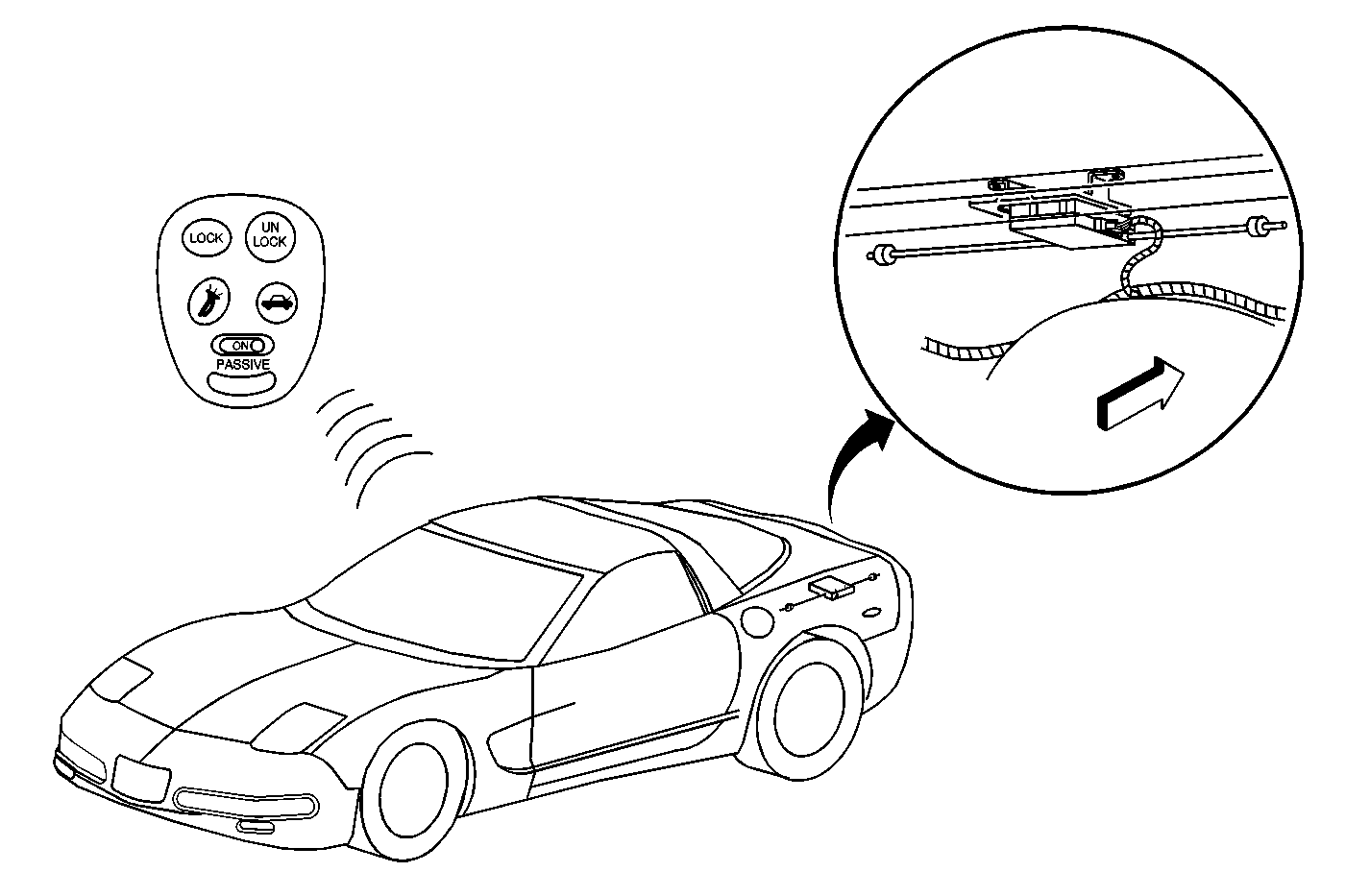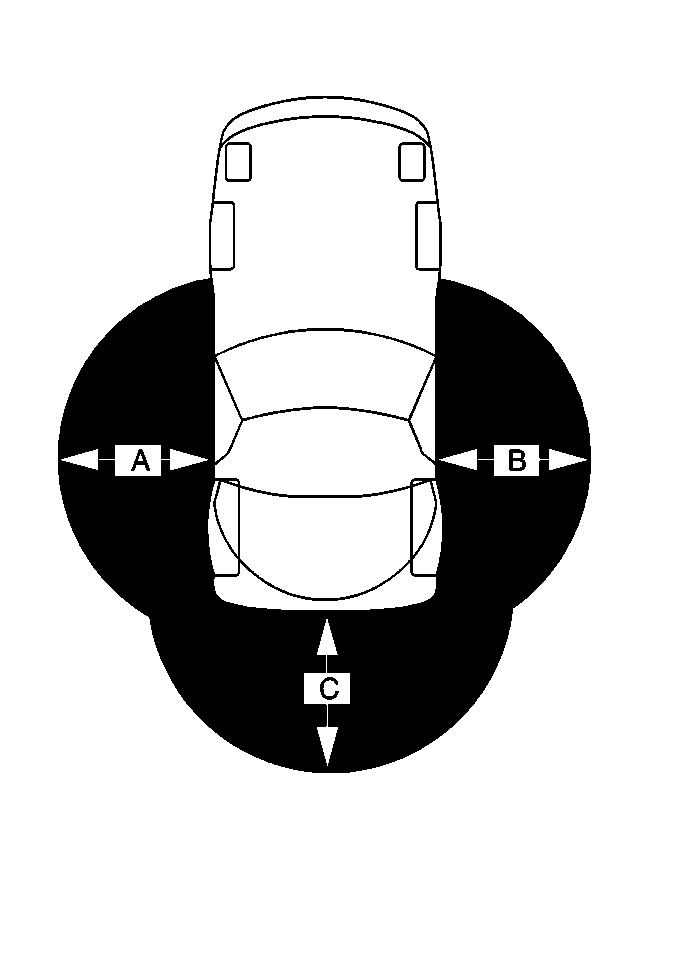Remote Function Actuation (RFA) System

The Remote Function Actuation
(RFA) system performs the following functions:
| • | Transmitter remote control of various vehicle systems without
physical contact of any switches on the vehicle |
| - | Lock and unlock the both doors |
| - | Turn the panic alarm ON or OFF |
| - | Arm or disarm the theft deterrent system |
| - | Vehicle lamp control (approach, courtesy) |
| - | Activate memory features (with memory option only) |
The RFA system consists of a transmitter located on the operator's key
fob, and a receiver (with an integral antenna) located over the LR wheelhouse.
The receiver is capable of recognizing three transmitter codes. The
RFA system does not directly control its functions, but relies on
other systems in order to perform the transmitter's commands. The
receiver receives and transmits various information from the following
systems in order to perform specific functions.
| • | The Body Control Module (BCM) -- in order to provide Theft
Deterrent, hatch release, horn, and vehicle illumination control features. |
| • | The Door Control Modules (DCM) -- in order to provide all
door lock and memory mirror functions. |
| • | The Seat Control Module (SCM) -- in order to provide memory
seat features. |
| • | The Instrument Panel Cluster (IPC) -- in order to provide
RFA system programming, display and vehicle personalization functions. |
When the RFA system receives a command from a transmitter, a message
is sent via the serial data line to the system module capable of performing
the needed function.
The RFA system is intended to be used as a supplementary to the vehicles
conventionally operated lock/unlock system. It is not intended to replace,
but should be used in conjunction with the door lock key. The
system could disable due to radio frequency interference or a low
transmitter battery. Therefore, always maintain vehicle access
with a door key.
RFA System Functions
The RFA system consists of the following major components:
| • | A low power signal transmitter (key fob) |
| • | A receiver with integrated antenna |
The RFA system allows the user to lock or unlock the vehicle through
a transmitter located on the user's key fob. The RFA transmitter is
a battery powered, water resistant, radio frequency signal generator.
The RFA transmitter consists of four manual buttons. The operation of the
keyless entry system is described below:
Manual Features
| • | Door UNLOCK Button -- with a programmed transmitter in range,
unlocks the driver and passenger doors (depending on personalized options
selected), disarms the theft deterrent system, activates illumination and
memory features (if equipped). |
| • | Door LOCK Button -- with a programmed transmitter in range,
locks the driver and passenger doors, arms the theft deterrent system. |
| • | HATCH Button -- with a programmed transmitter in range/trans
in park (Auto trans) parking brake applied (manual trans), releases the hatch
or trunk, disarms the theft deterrent system. |
| • | PANIC Button -- with a programmed transmitter in range (key
out of the ignition), activates the horns when pressed. |
When the transmitter manual UNLOCK button is pressed once, the transmitter
sends an identification code to the receiver to unlock the driver door. The
receiver sends the message to the driver DCM on the serial data
line to unlock the driver door. The DCM will then unlock the driver
door. The BCM also responds to this message and disarms the theft
deterrent system. The BCM will also activate the courtesy lamps
if the ambient light is low. If the UNLOCK button is pressed again
within 10 seconds, the receiver sends a second message
to the passenger DCM to unlock the passenger door. The DCM then
unlocks the passenger door.
When the transmitter manual LOCK button is pressed, the transmitter
sends an identification code to the receiver to lock both doors. The receiver
sends the message to both of the DCMs on the serial data line to
lock both doors. Both DCM will then lock both doors. The BCM
also responds to this message and arms the theft deterrent system.
When the manual HATCH button is pressed, the transmitter sends an identification
code to the receiver to release the hatch or trunk. The receiver sends the
message through the serial data line to the BCM. The BCM then disarms
the theft deterrent system and activates the hatch or trunk release
relay, and the hatch or trunk opens.
When the manual PANIC button is pressed, the transmitter sends an identification
code to the receiver to activate the panic mode. The receiver sends the message
through the serial data line to the BCM. The BCM activates the
horn relay or flashes the lamps (depending on selected personalized
options) for 90 seconds or until the panic button is
pressed again.
Personalization
The user of the RFA system, will be able to choose from the following
personalized options:
| • | Whether or not the passenger door unlocks with the driver door. |
| • | Approach lights illuminate with UNLOCK command (Manual button
press only). |
System personalization can only be accessed through the DIC by performing
the following procedure:
- Press the RESET button in order to clear any IPC warnings.
- Press the OPTIONS button on the DIC until the IPC displays PASSIVE
UNLK.
- Using the RESET button, select PASSIVE UNLK DRIVER or PASSIVE
UNLK BOTH.
- Press the OPTIONS button on the DIC until APPROACH LIGHTS is displayed.
- Using the RESET button, select ON or OFF.
Arming/Disarming Theft Deterrent
When the RFA system sends a lock command on the serial data line to
the DCMs, the DCMs will lock the doors and the BCM will arm the theft deterrent
system. The BCM then turns off the courtesy lamps and sound the horn,
indicating that the theft deterrent system is armed. Whenever the
doors are unlocked or the hatch is release, the BCM disarms the theft
deterrent system.
To send a DISARM theft deterrent message to the BCM, the RFA system
must see the following conditions:
| • | A valid transmitter is in range. |
| • | The key is not in the ignition. |
| • | The receiver has identified an active unlock command or the hatch
or trunk release command from a valid transmitter. |
To send an ARM theft deterrent message to the BCM, the RFA system must
see the following conditions:
| • | Transmitter LOCK button has been pressed. |
| • | The key is not in the ignition. |
RFA Operational Range
Operational range varies with the orientation of the transmitter. For
best performance, hold the transmitter vertically, with the buttons facing
you and the bottom cover of the transmitter towards the
vehicle. As battery life decreases, so does the maximum
operational range of the RFA transmitter. In most cases,
the transmitter battery should only be replaced when the operational
range has severely decreased. If the transmitter range
decreases or the transmitter does not operate, test for
the following conditions:
| • | Test if battery replacement is necessary |
| • | Test for proper range (Rainy or snowy weather decreases range) |
| • | Test for obstructions (other vehicles or objects will decrease
range) |
| • | Electrical interference (cellular phones, power lines, radio towers,
garage door openers, etc.) |
| • | The transmitter is not programmed or synchronized to the vehicle |
RFA Range Location

Range
| Transmitter Location
|
15.2-30.4 m
(50-100 ft)
| A, B, C
|


